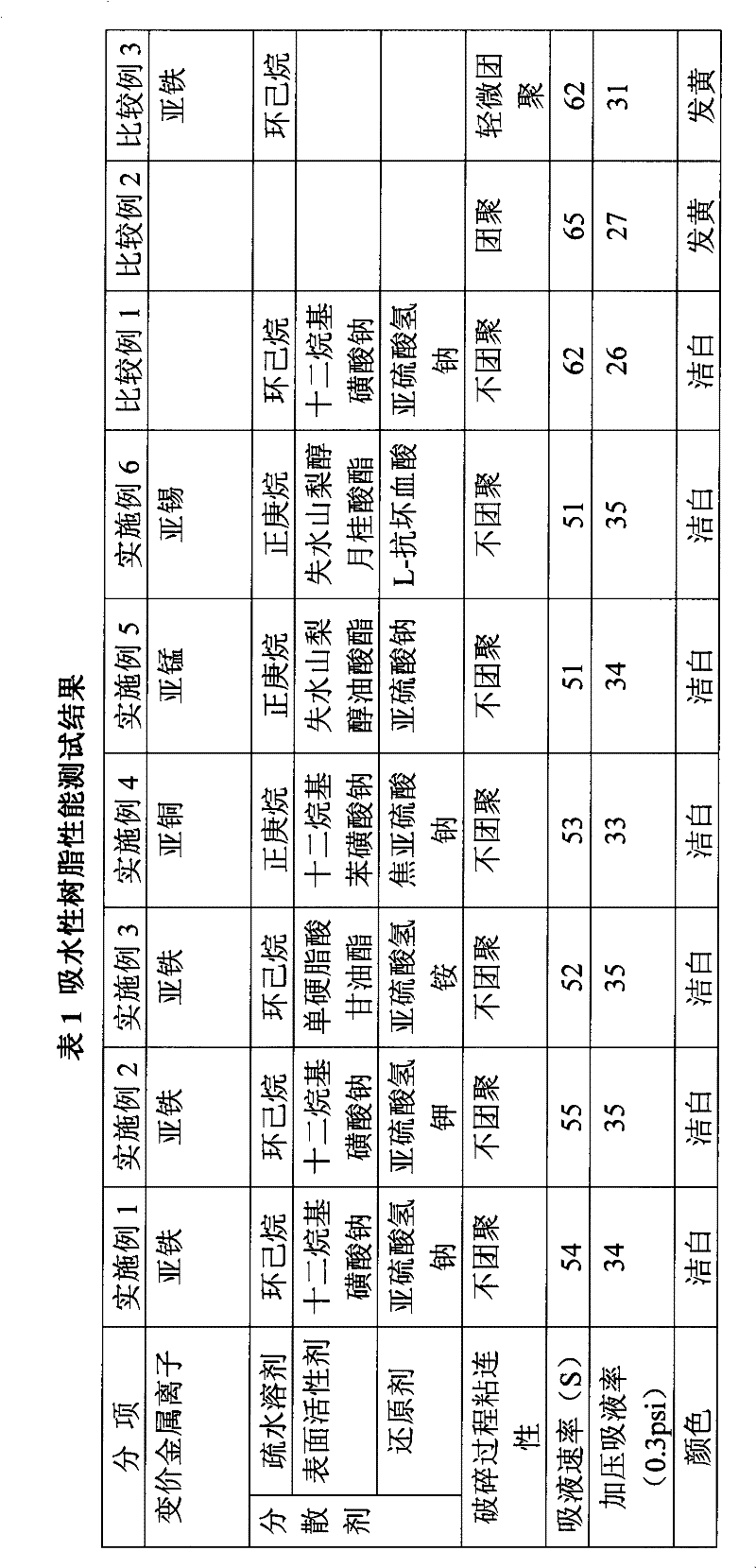Preparation method of crylic acid resin with high water absorbability
A technology of super absorbent resin and water absorbent resin, which is applied in absorbent pads, coatings, medical science and other directions, can solve the problems of prolonged production cycle, increased production cost, intolerant storage of acrylic acid, etc., and achieves quality improvement, quality improvement, color improvement white effect
- Summary
- Abstract
- Description
- Claims
- Application Information
AI Technical Summary
Problems solved by technology
Method used
Image
Examples
Embodiment 1
[0031]a) Add 2700g of high-purity acrylic acid and 800g of deionized water into a 10L reactor with a stirrer and a jacket cooling device, and then slowly add 3100g of 32wt% sodium hydroxide solution to the reaction under stirring and cooling conditions kettle for neutralization reaction.
[0032] b) The above sodium acrylate aqueous solution was fed into a jacketed double-arm kneader with a volume of 10 L and two sigma blades, and the air in the system was replaced with nitrogen while keeping the reaction liquid at 30°C. Then, while stirring the reaction solution, 1.08 g of N,N-methylenebisacrylamide, 8.1 g of ammonium persulfate, 8.1 g of sodium bisulfite and 0.015 g of ferrous chloride were added. Polymerization started quickly and the resulting hydrogel polymer was removed after 30 minutes. The hydrogel polymer has been divided into small pieces with a diameter of 20mm-100mm, and a small part of the colloid is agglomerated.
[0033] c) The above-mentioned granules are add...
Embodiment 2
[0037] a) Add 2700g of high-purity acrylic acid and 800g of deionized water into a 10L reactor with a stirrer and a jacket cooling device, and then slowly add 3100g of 32wt% sodium hydroxide solution to the reaction under stirring and cooling conditions kettle for neutralization reaction.
[0038] b) The above sodium acrylate aqueous solution was fed into a jacketed double-arm kneader with a volume of 10 L and two sigma blades, and the air in the system was replaced with nitrogen while keeping the reaction liquid at 30°C. Then, while stirring the reaction solution, 1.08 g of N,N-methylenebisacrylamide, 8.1 g of ammonium persulfate, 8.1 g of sodium bisulfite and 0.74 g of ferrous chloride were added. Polymerization started quickly and the resulting hydrogel polymer was removed after 30 minutes. The hydrogel polymer has been divided into small pieces with a diameter of 20mm-100mm, and a small part of the colloid is agglomerated.
[0039] c) Add the above-mentioned granules int...
Embodiment 3
[0043] a) Add 2700g of high-purity acrylic acid and 800g of deionized water into a 10L reactor with a stirrer and a jacket cooling device, and then slowly add 3100g of 32wt% sodium hydroxide solution to the reaction under stirring and cooling conditions kettle for neutralization reaction.
[0044] b) The above sodium acrylate aqueous solution was fed into a jacketed double-arm kneader with a volume of 10 L and two sigma blades, and the air in the system was replaced with nitrogen while keeping the reaction liquid at 30°C. Then, while stirring the reaction liquid, 1.08 g of N,N-methylenebisacrylamide, 8.1 g of ammonium persulfate, 8.1 g of sodium bisulfite and 0.15 g of ferrous chloride were added. Polymerization started quickly and the resulting hydrogel polymer was removed after 30 minutes. The hydrogel polymer has been divided into small pieces with a diameter of 20mm-100mm, and a small part of the colloid is agglomerated.
[0045] c) Add the above-mentioned granules into ...
PUM
| Property | Measurement | Unit |
|---|---|---|
| Particle size | aaaaa | aaaaa |
Abstract
Description
Claims
Application Information
 Login to View More
Login to View More - R&D
- Intellectual Property
- Life Sciences
- Materials
- Tech Scout
- Unparalleled Data Quality
- Higher Quality Content
- 60% Fewer Hallucinations
Browse by: Latest US Patents, China's latest patents, Technical Efficacy Thesaurus, Application Domain, Technology Topic, Popular Technical Reports.
© 2025 PatSnap. All rights reserved.Legal|Privacy policy|Modern Slavery Act Transparency Statement|Sitemap|About US| Contact US: help@patsnap.com

